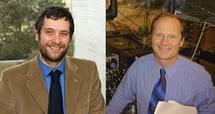CFEL Scientists Become Founding Directors of Max Planck Institute
Max Planck Society establishes new institute on Campus Bahrenfeld
By Manuel Gnida
Hamburg’s Science Campus Bahrenfeld will get a new research institute. The German Max Planck Society announced the establishment of a “Max Planck Institute for Structure and Dynamics of Matter” in a press release on Monday. Andrea Cavalleri and Dwayne Miller, two researchers at the Center for Free-Electron Laser Science (CFEL), have been named as founding directors. The new institute is a significant expansion of the successful Max Planck Research Department for Structural Dynamics at the University of Hamburg.
The Max Planck Institute will consist of five research divisions. In addition to the founding directors Miller and Cavalleri, heads of the former Max Planck Research Department, three more scientists will be appointed as directors of the remaining research divisions in the future. “Transforming the Max Planck Department into a Max Planck Institute is a substantial boost to our science,” says CFEL research coordinator Ralf Köhn. “The Institute will be more independent and will have more financial resources available. Finally, the expansion creates long-term stability for the affected research programs.”
Scientists at the new institute will study ultra-fast processes in a variety of important systems ranging from proteins to superconductors. Researchers in Dwayne Miller’s division, for instance, plan to create movies of chemical reactions with atomic resolution. They are particularly interested in observing proteins at work and, thus, understand their function. The scientists hope to derive the desired information by exposing protein samples to a beam of ultra-fast electrons. For this purpose, the Miller group has developed the unique “electron gun” REGAE. Miller’s team also develops a new laser method to cut biological tissue with a minimum amount of subsequent scarring. This technology may revolutionize the field of laser surgery in the near future.
Andrea Cavalleri and his team use laser light of various wavelengths to understand and control the collective properties of solids. Recently, the researchers have successfully employed laser pulses to switch an ordinary conductor into a superconducting state, i.e. the state in which the material’s electric resistance vanishes. One of the scientists’ goals is to direct materials into their superconducting state at unusual high temperatures, which would represent a great technological progress.
The future Max Planck Institute is also important for the City of Hamburg, which will likely contribute 37 million euros for the construction of a new building. “Hamburg’s Senate has the goal of turning Hamburg into an international center for structure research and increasing the international visibility of the Research Campus Bahrenfeld,” says Hamburg’s Science Senator Dorothee Stapelfeldt. Hamburg is certainly a prime location for this type of research. With CFEL, the Deutsches Elektronen-Synchrotron (DESY), the Max Planck Society, and Hamburg University have teamed up to advance the field of structure and dynamics research. With FLASH, PETRA III, REGAE, and the future European XFEL, scientists have access to state-of-the-art light and electron sources for their continuing research.
